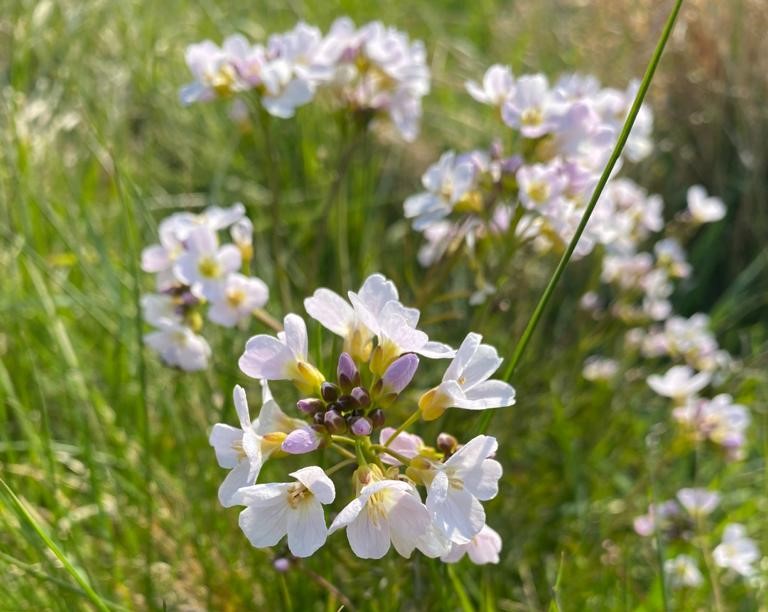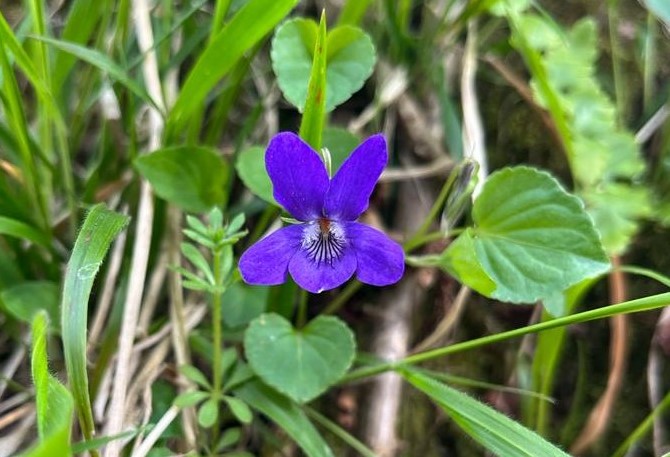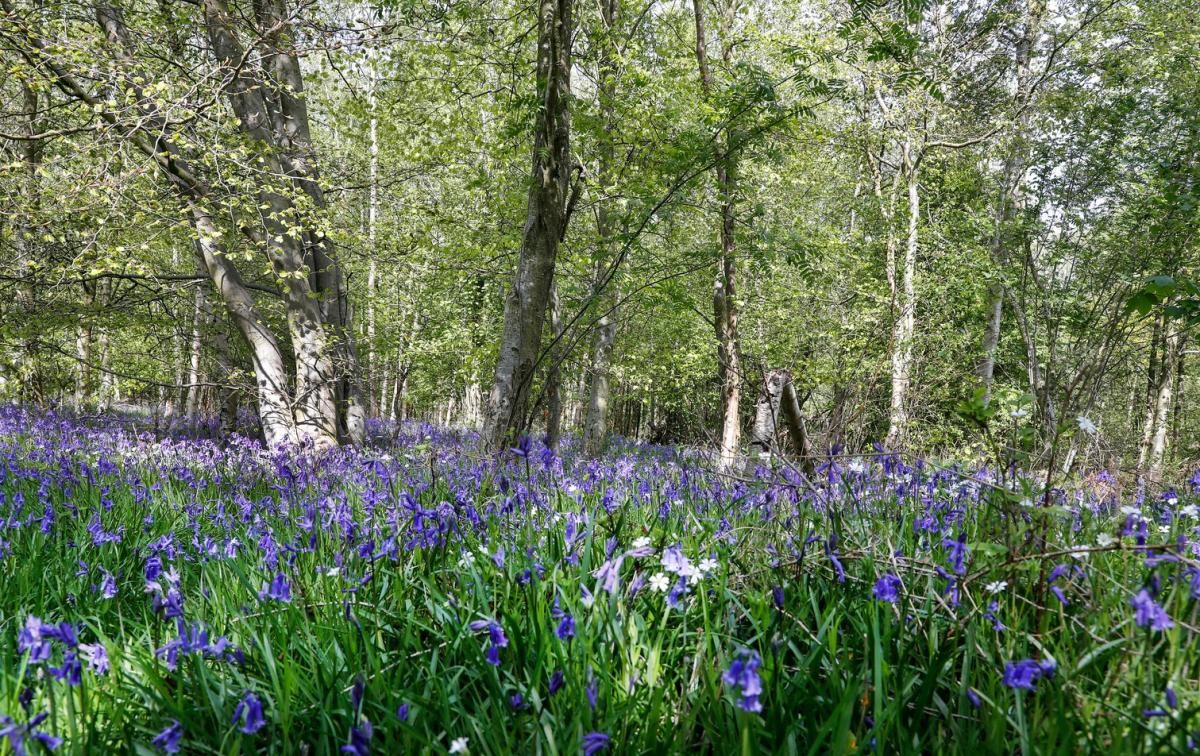
Spring flora of interest at Gorcott Hill Wood
Spring has truly sprung over at Gorcott Hill Wood! The woodland floor is a sea of colour with lots of springtime favourites, many of which indicate ancient woodland habitat. The grassland habitats are also beginning to come to life and are showing promise of what is to come in the summer months. Springtime blooms are a really important food source for early emerging pollinators such as the orange tip and peacock butterfly as well as buff-tailed and common carder bumblebees.
Wildflowers to spot
Here are just a few wildflowers that are flowering within the ancient semi-natural woodland and grassland at Gorcott Hill. Many of these can also be seen across other areas of the Forest in the springtime months.
Bluebell (Hyacinthoides non-scripta)

Found in swathes of beautiful purple-blue across the woodland floor, Gorcott Hill wood comes alive with the scent of bluebells during April and early May. Bluebells typically flower mid-April through May. They are associated with ancient woodland but can also be found along hedgerows and sparsely within grassland.
Bluebell flowers are usually deep purple-blue (though very rarely can be white or pink). The flowers are bell shaped, formed of 6 petals with up turned tips and droop to one side of the flowering stem. There can be between 4 -20 flowers on each stem! True English bluebells have white pollen and narrow pointed, smooth, hairless leaves. There are numerous folklore tales regarding bluebells, most of which involve fairies. Many believe that if you pick a bluebell, you will be led astray by fairies, forever wandering lost.
The bluebell is protected under the Wildlife and Countryside Act (1981), digging up the plant or bulb is prohibited, and landowners are prohibited from removing bluebells from their land to sell. Also listed on Schedule 8 of the Act (1998), trading in wild bluebell bulbs and seeds is an offence.
Bluebells are easily damaged and take years to recover from trampling, please take care whilst enjoying this springtime magic!
Wood anemone (Anemone nemorosa)
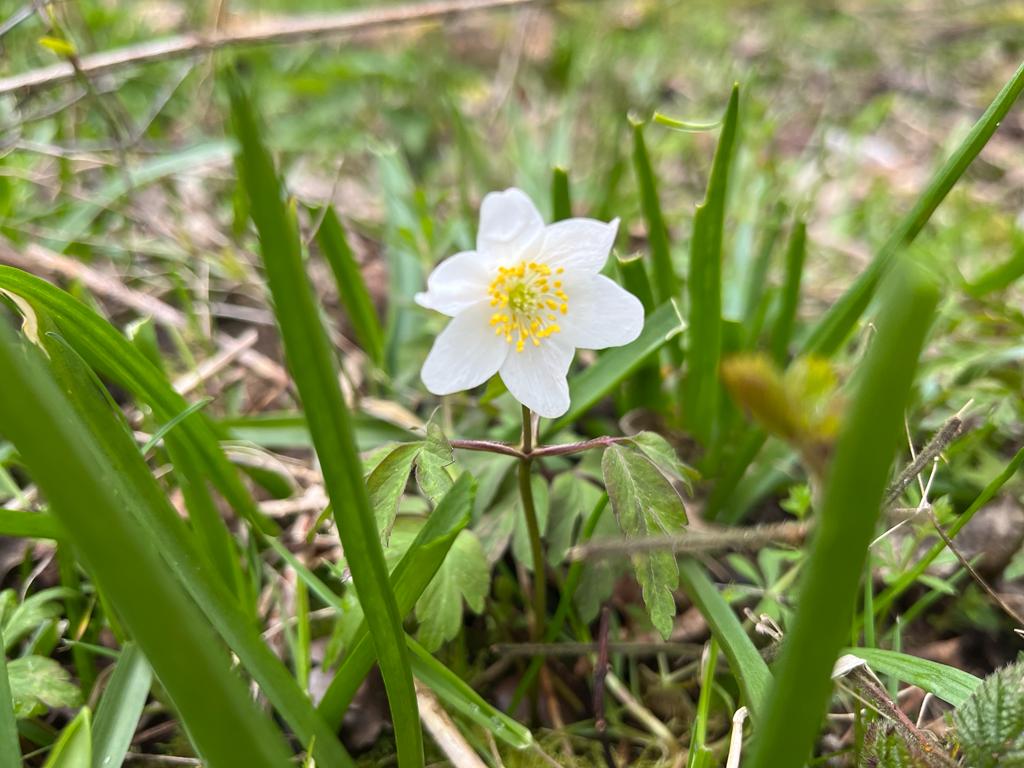
Wood anemone can be found sparsely throughout the woodland at Gorcott and is an indicator of ancient woodland. This wildflower flowers from March to May and favours ancient woodland habitat growing in dappled shade. Each flower is formed of white petals, sometimes with a pinkish tinge and its yellow anthers are a distinctive feature.
Wood anemone leaves are basal and divided into three lobes on long stalks. Wood anemone is a slow spreading plant, its seeds are mostly infertile, so it relies on rhizome growth! Did you know that wood anemones were named after the Greek god of wind Anemos? and are often referred to as ‘windflower’.
Greater stitchwort (Stellaria holostea)
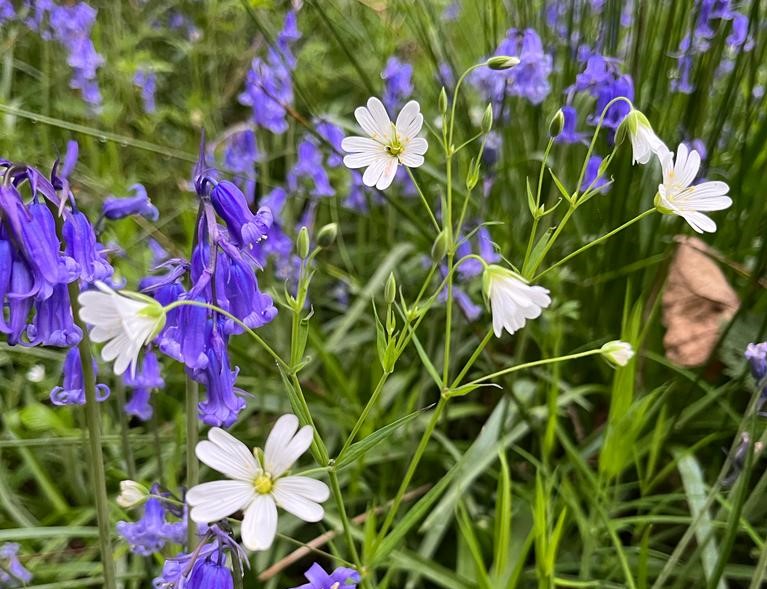
This delicate wildflower can be found interspersed amongst the swathes of bluebells throughout the majority of the woodland at Gorcott Hill. It typically flowers from April to June and is found in deciduous woodlands, along hedgerows and roadside verges. This wildflower can be seen in many of our more mature areas of woodland.
Greater stitchwort’s flowers are formed of five white petals which are split halfway down – sometimes giving the appearance of ten petals! The flowers are around 2-3cm in diameter, not to be confused with lesser stitchwort which has much smaller flowers at 0.5-1cm diameter. This wildflower has very thin and stalkless leaves, they are grass-like in appearance.
This plant was once used as a herbal remedy for a stitch, hence its name! However, in mythology some say that if picked a thunderstorm will be caused!
Yellow archangel (Lamium galeobdolon)
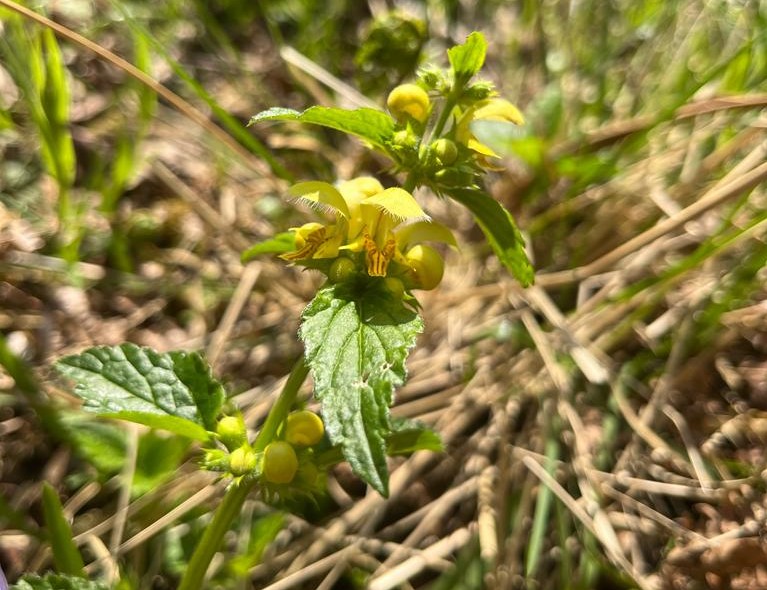
Yellow archangel can be seen sparsely within the woodland at Gorcott and is another indicator of ancient woodland. Often found amongst bluebells it flowers from April to July, preferring woodland habitats and damp shady ditches or hedgerows. Though it may look like a stinging nettle, yellow archangel is a part of the mint /dead-nettle family and is sometimes referred to as yellow dead-nettle.
Its hooded flowers are hairy and bright yellow with reddish-brown markings and form whorls around the stem. Yellow archangel has finely hairy oval or heart shaped toothed leaves resembling that of a stinging nettle. It is thought that yellow archangel may well have gotten its name from its virtue of not stinging.
Wood forget-me-not (Myosotis sylvatica)
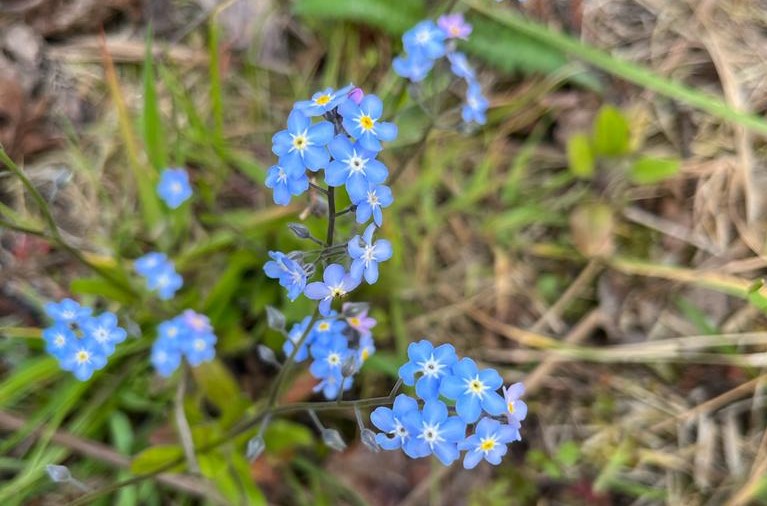
Delicate blue wood forget-me-not flowers can be seen along the woodland rides at Gorcott, particularly in areas where the sun can reach the woodland floor. This wildflower can be seen from April to June and favours damp/ wet woodlands, ancient woodlands, woodland rides, hedgerow and rocky grassland.
Multiple flowers formed of five petals grow off the same stalk and are bright sky to azure blue, with white to orange centres. Wood forget-me-not has hairy stems and narrow oval leaves. Although often considered to be a ‘weed’, in the language of flowers the forget-me-not symbolises true love and memories.
Primrose (Primula vulgaris)
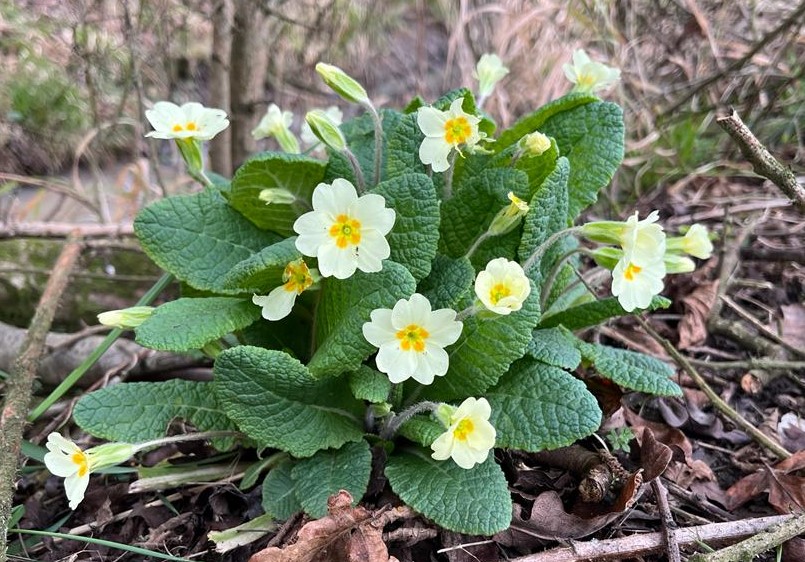
Primroses can be seen throughout the woodland at Gorcott and lines many of the woodland rides and edges. It can also be found along the edges of some of the hedgerows and along the grassland ditch.
The Primrose flowers March until May. They favour predominantly woodland habitats but can also be seen in grassland and edge habitats. Within the forest they can be seen throughout many of our older woodland sites and are an indicator of ancient woodland.
Primrose flowers have five notched petals and can vary from pale to deep yellow with a darker yellow/orange centre. Their leaves form rosettes and are wrinkled with a hairy underside. In folklore planting hanging Primroses within your doorway was considered an invitation to fairies.
Wood spurge (Euphorbia amygdaloides)
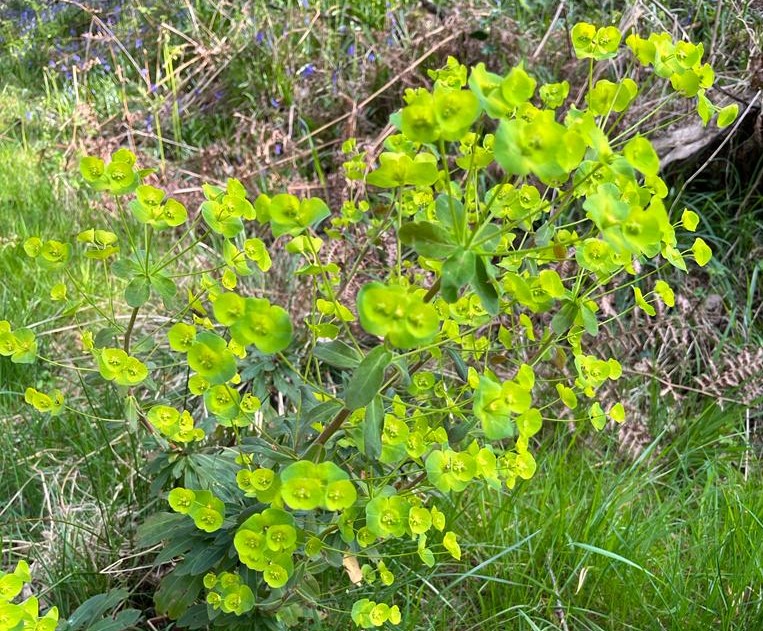
Wood spurge, an indicator of ancient woodland, lines many of the woodland rides at Gorcott Hill adding beautiful yellow-lime hues. It flowers March to May but the plant is present year-round. Wood spurge is typically found in old to ancient woodlands, favouring slightly acidic soils. Its yellow-green clusters of flowers have no petals and are instead held in cup-shaped bracts. Wood spurge has upright stems with long narrow leaves which are often tinged red.
This wildflower is often found in patches spreading through rhizome growth. Historically the milky white toxic sap produced by spurge has been used to tip poisoned arrows!
Cuckooflower (Cardamine pratensis)
Cuckooflower or Lady’s smock can be seen within some of Gorcott Hill woods grassland habitats. Flowering April to June, the cuckooflower typically prefers damp ground, favouring wet grassland, damp meadows, water margins (ponds/ streams/ ditches) and roadside verges. It is found in many of the Forest’s damper grassland areas.
Its four petal flowers are atop an upright stem and vary from pale to deep lilac and are rarely pure white. This wildflower has a basal rosette of larger leaflets followed by upper leaves with narrow leaflets. Cuckooflower is most commonly associated with the return of migrating cuckoos. But did you know that it is also an important food plant for the caterpillars of the orange tip butterfly?
Common dog-violet (Viola riviniana)
This small, unscented and delicate wildflower can be found dotted around all over Gorcott Hill. It has been recorded in the woodland, grassland and along the ditch. The common dog-violet flowers April to June and is found in woodland, grassland, hedgerow and heathland habitats. Its flowers are formed of five purple petals and have a white centre. Often confused with the early dog-violet it is important to note that the nectar spur is white or pale purple in the common, and darker violet in the early.
Common dog-violets have long stalked, dark green, heart shaped leaves. This wildflower is the main foodplant for silver-washed fritillary caterpillars, one of our priority species for Gorcott Hill Wood. Did you know that ‘dog’ refers to its lack of scent; dog, is a common English prefix for distinguishing a species considered inferior to a superior relative.
Lesser celandine (Ranunculus ficaria)

Lesser celandine is found throughout the woodland at Gorcott as well as along ditch edges. It flowers February to May and is one of the first signs of spring! This plant favours damp woodlands, meadows and banks (streams/ditches). Its beautiful shiny yellow flowers can have between 8 – 12 petals and its leaves form dark green heart shapes.
This wildflower can be found throughout the Forest’s damper habitats. Did you know the word celandine comes from the Greek word meaning swallow? It is thought that this wildflower blooms coinciding with the reappearance of swallows!
Wildflowers for pollinators

The ground flora at Gorcott Hill Wood is everchanging and each season brings a whole new host of colours and scents to the woodland floor and grassland. With this comes different waves of pollinators adapted to exploit the nectar sources available to them. It is a truly exciting transition to watch unfold and to learn about each of the new blooms!
Get your hands on an ID guide and get stuck in out and about around the Forest! For beginners we recommend ‘Collins Wild Flower Guide 2nd edition’, and ‘The Wild Flower Key’ by Francis Rose for more experienced botanists. Be sure to share your findings with us on social media by tagging @heartofenglandforest on Facebook, @theheartofenglandforest on Instagram, and @The_HOEF on Twitter.


